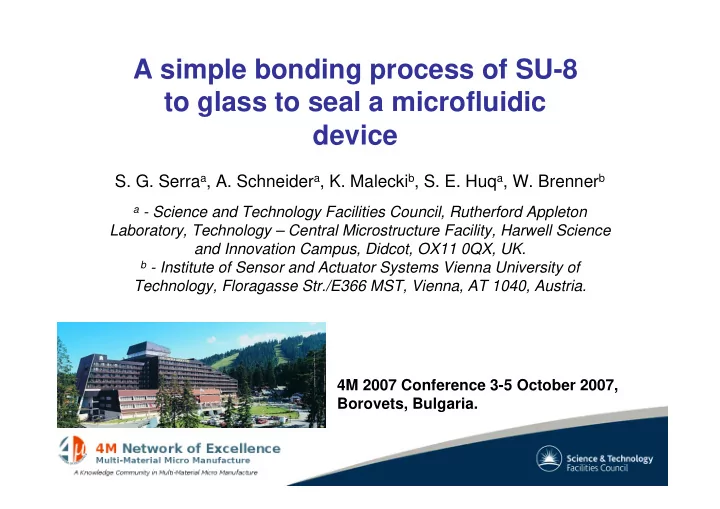

A simple bonding process of SU-8 to glass to seal a microfluidic device S. G. Serra a , A. Schneider a , K. Malecki b , S. E. Huq a , W. Brenner b a - Science and Technology Facilities Council, Rutherford Appleton Laboratory, Technology – Central Microstructure Facility, Harwell Science and Innovation Campus, Didcot, OX11 0QX, UK. b - Institute of Sensor and Actuator Systems Vienna University of Technology, Floragasse Str./E366 MST, Vienna, AT 1040, Austria. 4M 2007 Conference 3-5 October 2007, Borovets, Bulgaria.
Presentation content - Introduction - Experimental methods and results - Conclusion
Introduction The purpose is to seal a microfluidic cell trapping device with a drilled glass lid. The device is made of a SU-8 resist pattern on a glass substrate. A glass lid will be bonded to the top of the SU-8 pattern. The whole SU-8 structure is sandwiched between two Pyrex glass substrates. It is fully transparent to allow light penetration and visual observation of the cells. The SU-8 is spin coated and patterned by standard UV photolithography in order to produce a layer with 30 � m thickness and channels with 5 � m width.
Introduction The method to seal SU-8 fluidic devices is through adhesive bonding with a pre- drilled cover lid. This is done by applying pressure to the sample while heating above the glass transition temperature (Tg) of the SU-8.
Introduction For the first tests, samples were bonded at wafer scale (each 4” wafer had 12 chips). It was used a bonding machine with a vacuum chamber and alignment tools. After bonding, the individual chips were diced with a dicing saw machine. This is an expensive process that requires complex and specialized equipment. For optimizing process parameters (pressure, temperature), there was the need to develop an alternative bonding process compatible with SU-8 that is cheaper and simple.
Procedures and results To identify a suitable bonding temperature, Tg of patterned SU-8 was obtained by Dynamic Mechanical Analysis (DMA) first. The DMA result was Tg=175˚C.
Procedures and results Before bonding, each chip was individually diced from the wafer, using a simple diamond tip cutter. The pressure was applied using a customized in-house made manual press with bolted joint design. A torque wrench was used to tighten the bolt with a specific torque. While kept under pressure, the samples were heated in a convection oven at 180˚C for 1h.
Procedures and results Corel Paint Shop Pro X software was used to determine the percentage of bonded area in each microfluidic chip. The best results (90% bonded area) were achieved for a bonding pressure of 2.48MPa. Pressures above 2.48MPa increased the number of cracks on the lid. Below 2.48MPa the percentage of bonded area was lower.
Procedures and results A good alignment between the via-holes and the channels inlets was achieved. The shape and dimensions of the SU-8 microstructures had not changed during bonding process. The reflow of SU-8 allowed the filling of gaps caused by the presence of particles.
Procedures and results To determine the bonding strength pull-out tests on bonded samples were performed. The bonded chips were fixed between two metal bolts, using an epoxy glue, and fitted into the pull-testing machine. A bonding strength of 1.15MPa was obtained. 400 300 Force (N) 200 100 0 0.0 0.1 0.2 0.3 Distance (mm)
Procedures and results It was impossible to bond the samples cleaned with O 2 plasma. This plasma process, that removes surface uncrosslinked and crosslinked SU- 8, is used to improve the quality of the patterned structures after lithography. However, for the adhesive bonding it is necessary to have residual uncrosslinked SU-8 to allow reflow during the bonding process.
Conclusion A direct adhesive bonding of SU-8 structures to a glass lid was demonstrated in a single chip fabrication method. This method is cheaper and more simple then using a complex bonding machine and a dicing saw. There was no need for an extra adhesive SU-8 layer on the lid that would present problems with the drilled via-holes. Also its easier then bonding by very precise dispensing of glue were a very flat surface and very precise glue dispensers are required. The O 2 plasma cleaning process on the SU-8 is not suitable for the adhesive bonding. This low-cost and low temperature process will enable the sealing of MEMS structures for microfluidic and also micro-optical applications.
Acknowledgements This work was carried out within the 4M Multi-Material Micro Manufacture Network of Excellence and the FP6 Marie Curie Research Training Network “ASSEMIC” - Advanced Methods and Tools for Handling and Assembly in Microtechnology.
The End Thank you for your attention!
Recommend
More recommend